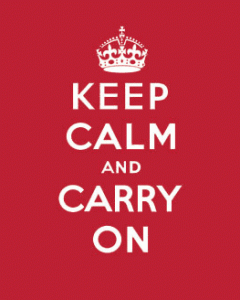At class yesterday Sarah and Shari were touting the latest in Ashtanga fashion wear in the form of vests with this fine message: “Keep calm and carry on”. It’s hilarious and so apt for us Ashtangis.
One of the ideas that I’m exploring at the moment is: How do I create a sustainable practice? The old timer Ashtangis like David Swenson, talk about how one should feel refreshed and energized after practice.
For the first year or so this seemed totally impossible. Pretty much all the postures were challenging me and I was challenging myself and pushing too hard. This left me feeling exhausted and led to injuries. But somehow I’ve stuck with it.
One idea that Shari shared with me over coffee the other morning is to only use the muscles necessary for the asana you’re in. This sounds like a no brainer but just try it! I am generally clenching my butt and or clenching my jaw to some degree.
The breathe is another key indicator in my level of calmness if it’s short and fast then I’m overdoing it and need to ease back a bit.
If I’m going to be practicing 5 or 6 days a week for the rest of my life then what attitudes to I need to change in order to help me sustain my practice? Plenty of food for thought there.


Using only the muscles required certainly sounds like a no brainer, but I think you’ll need to have been practising regularly as long as Swenson for this to be second nature. I too sometimes catch myself clenching teeth when I thought I was relaxed!
Like you, I’ve injured myself in the past with my practice, treating it like a competition and setting ‘goals’ rather than accepting where I am on any day.
Now we’ve all been told enough and know, at least intellectually, that the breath is everything, but how do you incorporate this understanding into your practice?
I’ve been lucky enough to study with some teachers who have really made me study my breath; not just how loud (or absent!) it is, but also its symmetry and cadence. From our breath comes our strength and endurance, but is also what gives me the delicious feeling of calm, even when doing things which physically, on their own, would have me begging for mercy.
Short, fast breaths certainly can be a good indicator of too much intent and not enough relaxation, but I find varying the speed of breathing from practice to practice, while keeping it deep and full, is an excellent way of mixing things up. On any day my breath will have its natural speed, but consciously speeding it up or slowing it down for the session I’ve found can have quite profound effects. One of the reasons I think led classes can be so difficult is that you’re not going at your own pace, regardless of whether it’s faster or slower.
I saw a video of Lino Miele doing full vinyasa. Of course his physical practice was amazing, but what really blew my mind was the soundtrack; nothing but his breath, constant and equal and very difficult to tell the inhale from the exhale.
As for feeling energised after practice, I got to this stage after one extended period in India and was shocked at the realisation. When I started ashtanga I could not believe how physically demanding it was, and could not accept I’d ever be anything but spent after attempting full practice.
I should add that this was full practice, but with one vinyasa between postures, as lifting up between sides is my teacher’s prescription until you reach the energised after savasana stage. After this I switched to vinyasa both sides and again felt pretty knackered. I didn’t manage to keep my practice going enough to start feeling energised after that routine, but of course it would come in time.
Anyway, I seem to have rambled off course somewhat! I’ll leave you with the bit of wisdom whose source I cannot remember: Any practice is good practice :o)
Hey John-Mark,
Thanks for your comment! It’s great to have someone contributing to the blog.
Your comments on the breath are certainly interesting. I’d never thought of consciously using my breath to change the pace of my practice!
I went searching on youtube for Lino Miele and found this amazing video of him practicing Kukkutasana: